Impressive near-IR images of Uranus and Jupiter by means of the adaptive optics system of the Telescopio Nazionale Galileo, AdOpt@TNG
Impressive near-IR images of Uranus and Jupiter by means of the adaptive optics system of the Telescopio Nazionale Galileo, AdOpt@TNG. The feasibility test of closing the loop on up-to ~ 4arcsec extended sources was successful !An amazing result after the images of Neptune in the 2004 summer.
AdOpt@TNG closed loop on Uranus taking hi-resolution near-IR images of the planet. The rings are visible in H and CH4L band.
On October 23rd, 2007, some tests had been done to verify the possibility to close the adaptive optics loop on Uranus as extended source (V=5.8, ø~3.6arcsec). Closing the loop allowed for a sequence of hi-resolution images of the planet in the near-IR band.
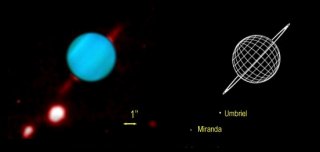
This false colors composition is the sum of several exposures of Uranus in closed loop through the filters Js (60sec exposure with a 5mag neutral filter), CH4L (60sec exposure) and H (60sec exposure). The rings were exposed in CH4L (180sec exposure) and successively inserted in the colored composition of the planet. The moons appear stretched due to their movement around the planet during the period of the exposures. Seeing was between 0.7 and 1.2arcsec in the visible band. A SR =0.34 and a FWHM = 0.17arcsec were measured on one of the moon of Uranus (not all visible in this image).
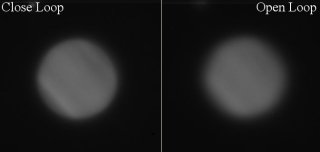
Closed vs Open loop preliminary images of Uranus in H band (60sec exposure). Equatorial bands are better visible in the closed loop image (on top-left). By increasing the intensity cuts of such images, the rings of Uranus are well visible in closed loop mode (bottom-left) and just perceptible in open loop one (bottom-right).
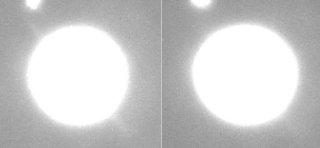
Hi-resolution near-IR images of Jupiter obtained with AdOpt@TNG and closing the loop on its moon Io.
On July 20th, 2007, some tests had been done on Jupiter to verify the possibility to close the adaptive optics loop on a sufficiently bright moon of the planet (extended source). Io was selected (V=5.41, ø~1.1arcsec) at a distance between 5 and 20arcsec from the border of the planet. Closing the loop allowed for a sequence of hi-resolution images of the planet in the near-IR band.
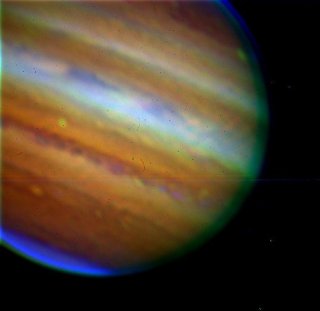
This false colors composition is the sum of several exposures of Jupiter in closed loop through the filters 1mic (40sec exposure with a 5mag neutral filter), CH4L (3sec exposure) and BrG (60sec exposure). The elapsed time of nine minutes between the beginning and the end of the image sequence produced a rotation of ~ 6º of the planet. Some offsets had to be applied in the reduction of the images before summing. A faster sequence should be foreseen to prevent such a problem in future runs. Seeing was between 0.6 and 1.0arcsec in the visible band.
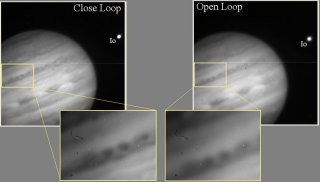
In these H band raw images it is clear the improvement in image quality obtained with AdOpt@TNG. The two images had been taken in H band with a 5mag neutral filter attenuator and 40sec exposure. Io has been used as reference source to close the loop. The center of the small yellow bordered window is ~ 40arcsec far away from the reference object (Io).
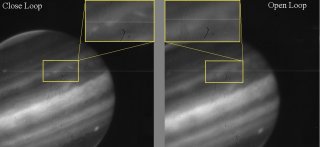
Also in these K´ band raw images it is clearly visible the improvement due to the adaptive optics. The two images have been taken in the K´ band with a 3sec exposure. Io (n ot visible in the images) has been used as a reference object to close the loop.
Hi-resolution near-IR images of Neptune obtained with AdOpt@TNG and closing the loop on its moon Triton.
On August 13th, 2004, some tests had been done on Neptune (V=7.8, ø~2.35arcsec) to verify the possibility to close the adaptive optics loop on its faint moon Triton (V=13.5, ø~0.13arcsec). Closing the loop allowed for a sequence of hi-resolution images of the planet in the near-IR band.
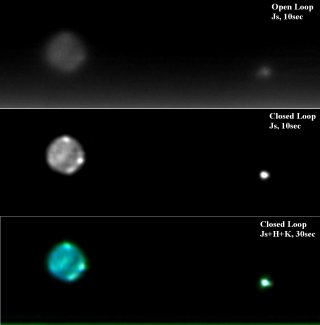
The improvement of the image quality is still impressive at naked-eye in Js band. The
features in the equatorial bands are amazing. An estimate of the resolution could be done
taking into account the size of Neptune itself, that is, 2.35arcsecs!
Please, contact Massimo Cecconi (cecconi@tng.iac.es) for further details and observation opportunity.

